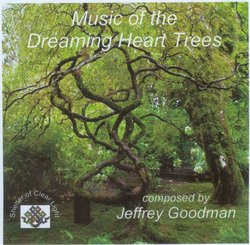| All Artists: Jeffrey Goodman Title: Music of the Dreaming Heart Trees Members Wishing: 1 Total Copies: 0 Label: Shelter of Clear Light Release Date: 7/1/2007 Genre: New Age Style: Number of Discs: 1 SwapaCD Credits: 1 UPC: 634479477607 |
Search - Jeffrey Goodman :: Music of the Dreaming Heart Trees
 | Jeffrey Goodman Music of the Dreaming Heart Trees Genre: New Age
Music of the Dreaming Heart Trees 4 Dreams 5 Meditations & 2 Invocations On a remote island northwest of Bali, there is a hidden cove where two ancient Dreaming Heart Trees are perched on a bluff overlooking a wild... more » |
Larger Image |
CD Details
Synopsis
Product Description
Music of the Dreaming Heart Trees 4 Dreams 5 Meditations & 2 Invocations On a remote island northwest of Bali, there is a hidden cove where two ancient Dreaming Heart Trees are perched on a bluff overlooking a wild beach. Named after ramphal or Rama's fruit, the trees are known for the dream-inducing nectar of their heart-shaped fruits. More than 100 years ago, a group of Balinese fishermen discovered the hidden cove and the Dreaming Heart Trees after they had been thrown off course by a sudden storm. After fishing in the cove all morning, one of the fishermen, named Gajah Mada, who was also a noted gamelan musician, saw a sparkling white rainbow arching from the horizon and ending at the base of the Dreaming Heart Trees. Along the rainbow he saw a magical guaksa bird flying toward the two trees. Since childhood he had heard of this magical bird in stories from the sacred Hindu epic Ramayana, and with great curiosity he decided to take his saung kauk (a 13-string harp of Burmese origin) to play beneath the Dreaming Heart Trees where the guaksa now perched. Above him a flock of songbirds also gathered along the branches, and when they all began to sing and drink the nectar of the heart fruits, Gajah Mada also partook of the nectar and began to play his saung kauk. Then the dream nectar took effect and he fell into a deep sleep. While in a sleeping trance he had a vision that the trees had beckoned the guaksa to peck small holes along the tree branches, each of a different size. When the guaksa had finished making the holes, the two trees began to sway as the ocean air passed through the holes inscribed within their branches. Enchanting melodies began to sound. The melodies from the larger tree sounded like flutes or woodwinds, and the melodies of the smaller tree sounded like violins or cellos. Gajah Mada then realized that the trees had become musical instruments: they could now play impassioned love songs with one another as the ocean breezes blew through their resonating branches. With the sounds of the ocean waves breaking in the hidden cove, Gajah Mada again picked up his harp and played along with the swaying trees, the guaksa and the singing birds. He improvised for hours with rapt attention and inspiration, also adding delicate sounds of hand bells and small gongs that he had carried with him. At last, upon awakening from his vision, he began to write of his experience and notate the music. Previously unknown to the world, the manuscript of Gajah Mada s music and story were found by sheer chance in an antiquities shop in the Balinese city of Singaraga. The owner had been cleaning up his shop when he noticed a much-battered Burmese harp. When he checked to see if it was worth keeping, he noticed a volume of old of papers lodged within the harp s resonator box. He removed it and the manuscript was the very one which Gajah Mada had notated more than a century ago upon waking from his visionary trance. The 4 Dreams, 5 Meditations and 2 Invocations all originate from this Music of the Dreaming Heart Trees and the inspired notations of Gajah Mada.

 Track Listings (11) - Disc #1
Track Listings (11) - Disc #1